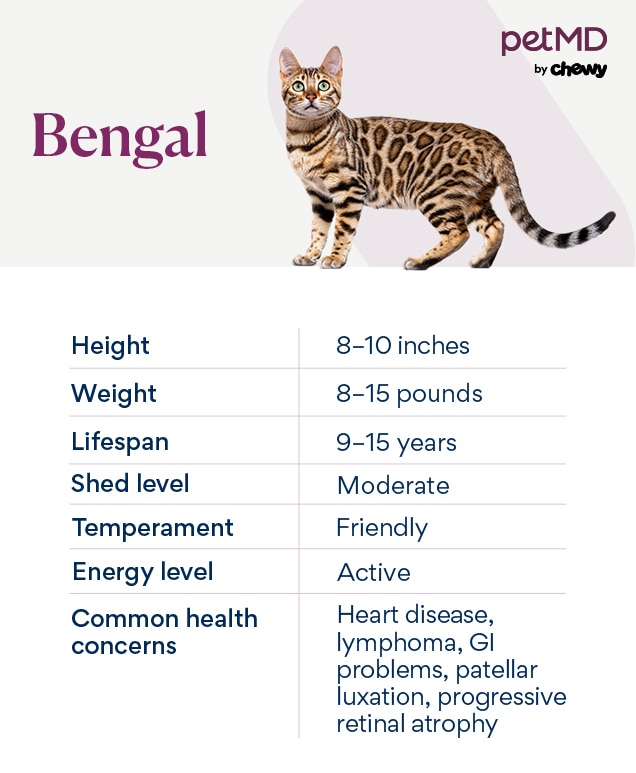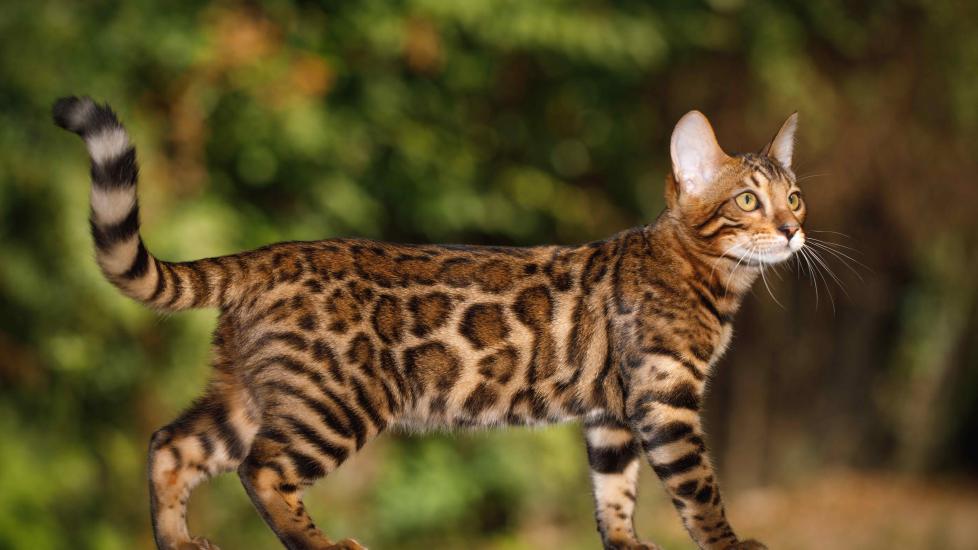Bengal
When you look at a Bengal cat, you might mistake them for a mini leopard—and you wouldn’t be far off. “A Bengal is a beautiful cross between a domestic shorthair and an Asian leopard cat,” says Jennifer Frione, DVM, owner of Lakeside Animal Hospital in Plantation, Florida. While Bengals are wild at heart, their curiosity and athleticism makes them beloved companions for the experienced cat parent.
As with the similarly exotic Savannah cat, before setting your sights on this leopard lookalike, you’ll need to check your local and state regulations. Some states ban Bengal cats, while others permit them outside of urban areas if your cat is of a later generation.
Caring for a Bengal

Bengal cats are classified by “F” followed by a number. That’s their filial rating, or how many generations the cat is removed from the initial cross. Therefore, F1 means a Bengal kitten is the first cross between a wild leopard cat and a domestic cat—a “low” generation. As the generations progress, the cats become smaller and more similar in personality to domestic cats, while retaining their spotted appearance.
Even if your state allows F1 Bengal cats, Frione recommends that pet parents consider purchasing high-generation Bengals, because low-generation cats are most like their wild leopard cat ancestors.
Be warned: Bengals are not lazy cats! Depending on their generation, they usually need a more active lifestyle and stimulating environment than other domestic breeds. Additionally, they’re not the best fit for families with small children because they usually don’t like being held and have a strong hunting instinct, Frione says.
Shop for Your Breed
Bengal Cat Health Issues
Bengal cats have an average lifespan of 12–16 years. They’re a relatively healthy breed, but are prone to some genetic health conditions. Therefore, you might want to consider purchasing cat insurance for your Bengal kitten.
Lymphoma
All cats are at risk of developing cancer, but some breeds are generally more likely than others to develop specific types of cancer. Bengal cats are more likely to develop lymphoma than other breeds, Frione says.
Lymphoma is a cancer that affects the lymphatic system—the lymph nodes, ducts, spleen, bone marrow, thymus, and parts of the gastrointestinal tract—but intestinal lymphoma is the most common in cats. If your cat is diagnosed with lymphoma, your veterinarian will determine the most effective approach based on the cancer’s location and stage. Chemotherapy is commonly recommended, along with surgery and/or radiation.
Gastrointestinal Conditions
In addition to the increased risk of intestinal lymphoma, Frione says Bengal cats are prone to GI upsets. It might be due to their curious nature leading them to nibble on things they shouldn’t, like houseplants, she says. The Bengal Rescue organization says irritable bowel disease may also be to blame.
If your cat has any unusual vomiting, diarrhea, or change in appetite, they should be examined by their veterinarian to determine the cause and develop a treatment plan.
Patellar Luxation
Bengal cats are known for their athleticism. But unfortunately, they’re not all born with sturdy knees that support their active lifestyle. Patellar luxation occurs when the kneecap moves or becomes dislocated from its normal position. To avoid discomfort and early onset arthritis, your veterinarian may prescribe anti-inflammatories or recommend corrective surgery, depending on the condition’s severity.
Hypertrophic Cardiomyopathy (HCM)
This is the most common heart disease in cats and is characterized by thickening heart muscle. Because symptoms are not always apparent, responsible breeders should always genetically test both parents for hypertrophic cardiomyopathy (HCM) before breeding. However, genetic testing can’t detect all forms of HCM, so routine wellness visits with your veterinarian are crucial for catching the disease early.
Progressive Retinal Atrophy (PRA)
Bengal cats can develop a genetic condition that causes retinal deterioration, called progressive retinal atrophy (PRA). Unfortunately, there is no cure for this disease, and it eventually leads to blindness. However, cats without vision can live a full and happy life with some extra help around the house. There are two types of PRA:
-
A hereditary form affecting kittens about 2–3 months old
-
A later-onset form found in cats between 2–5 years old
The first symptom of either type is night blindness. As with HCM, ethical Bengal breeders should always genetically test both parents for the disease before breeding kittens.
Pyruvate Kinase Deficiency (PKD)
Pyruvate kinase deficiency (PKD) is a genetic disorder in cats that causes a shortage of the enzyme pyruvate kinase (PK). This causes red blood cells to break down faster than normal, leading to anemia or other blood-related conditions. Luckily, PKD can be genetically tested for, reducing the risk of PKD in kittens.
What To Feed a Bengal Cat
Bengal cats don’t require a special diet outside of quality commercial cat food. Food should meet the nutritional recommendations set by the Association of American Feed Control Officials (AAFCO), ensuring the recipe provides all the nutrients and vitamins they need.
How To Feed a Bengal
Like their Asian leopard cat relatives, Bengals love to hunt and forage for food. Incorporating food puzzles, lick mats, and food-dispensing toys into meal and snack times can help your Bengal exercise their natural prey drive. Rather than free-feeding your Bengal, consider offering them multiple small meals a day to mimic a cat’s natural feeding cycle.
How Much Should You Feed a Bengal?
Full-grown Bengal cats of lower generations can be as heavy as 15 pounds and stand as tall as 10 inches. Bengals of higher generations are more similar in size to their domestic relatives, weighing around 8–12 pounds and measuring approximately 8–10 inches in height. Regardless of their generation, Bengal cats typically have a lean and muscular body.
Maintaining their slim build means feeding your Bengal cat an appropriate number of calories based on their age and activity level. Your veterinarian can help you figure out the right amount and may suggest dietary changes, such as fewer calories or weight-control food for overweight cats.
Nutritional Tips for Bengals
When feeding cats complete and balanced meals that meet AAFCO’s recommended nutritional profiles, there’s typically no need to give them additional nutrients or vitamins. But if your Bengal has health problems, your veterinarian may suggest specific supplements to support your cat’s health.
Behavior and Training Tips for Bengals
Bengal Cat Personality and Temperament
Bengals are very active and curious felines, more than a typical lap cat. They require a lot of stimulation and enrichment for their playful personality, Frione says, and they’re not afraid to vocalize their needs.
Sharing a household with dogs and other cats may be okay with proper introductions, according to Frione. However, Bengals tend to be more territorial than other domestic cat breeds and they have a high prey drive, so smaller pets—or pets that are timid—might not be good companions for a big Bengal.
They can happily live in a house or apartment, as long as there’s enough vertical space for exercise. Cat trees, scratching posts, and cat shelves can all turn a small space into a cat-friendly abode.
Bengal Behavior
Kitten-proofing your home before welcoming a Bengal is a good idea. These cats (especially Bengal kittens) have a propensity for getting into things they shouldn’t. Their curiosity and intelligence lead them to entertaining antics, like their love of water and knack for learning new tricks.
Like any cat, boredom can lead to destructive behaviors. So, always ensure your Bengal has plenty of opportunities to run, jump, and play. After a full day of exploration, don’t be surprised to find your Bengal kitty curling up beside you for a long catnap.
Bengal Training
According to Frione, learning new tricks is a favorite pastime of most Bengal cats and kittens. They’re also popular candidates for leash and harness training, because they feel right at home in the great outdoors. However, never let your Bengal cat roam outdoors off-leash, as they can easily get into trouble.
Fun Activities for Bengal Cats
-
Sunbathing in a catio
-
Playing fetch
-
Exploring vertical spaces
-
Birdwatching
-
Foraging for treats
-
Food puzzles
-
Walking on a harness and leash
-
Learning new tricks
-
Playing with other pets
Bengal Grooming Guide
As cats that look like a leopard, Bengals have spots or marbling that can come in various shades, including brown and silver. They have a short, single-layered coat that is described as “glittering in the light and silky smooth to the touch.” They also don’t shed much and need minimal grooming besides normal cat care.
Skin Care
Bengal cats don’t need regular baths, but they often invite themselves into showers and baths due to their love of water.
Coat Care
“Due to their short coat, Bengals don’t require special or extensive grooming,” Frione says. Like other cat breeds, they should be brushed weekly to reduce shedding and prevent matting.
Eye Care
Most Bengals have big eyes that are typically green, yellow, or gold, though some with more unusual coat colors can have blue eyes. While their eyes don’t require any special care, if you notice any changes in your cat’s vision (for instance, if they begin bumping into things or seeming confused), take your cat to the vet to have their eyes assessed for PRA.
Ear Care
Keeping your cat’s ears clean and dry, particularly after bathing or swimming, can help prevent ear infections. Signs of ear infections in cats include an unpleasant odor, discharge, and irritation of the ear.
Considerations for Pet Parents
Bengals are a striking hybrid of a domestic shorthair and the Asian Leopard cat that loves to explore and play. If you want to buy or adopt a Bengal cat or kitten, check local and state laws first. Some places don’t allow Bengals or only allow higher generations. And remember: The higher the generation, the more domestic cat-like they act.
Bengals usually need more activity and enrichment than other cat breeds, and they may not get along well with young kids and some pets due to their high prey drive. Before welcoming a Bengal, make sure you can provide daily activity—Bengals can easily become bored. Indoor toys such as cat wheels, perches, and feeder puzzles can all enhance your cat’s quality of life.
Bengal Cat FAQs
Are Bengal cats hypoallergenic?
Bengal cats have a smooth, short coat that is low-shedding, making them a potential option for people with mild allergies. However, because allergens are in cats’ saliva and skin, not just the fur, no cat breed can be considered entirely hypoallergenic.
How much is a Bengal cat?
Depending on the generation, Bengal cat costs range from $1,500–$4,000, Frione says. Along with breeder or adoption fees, it’s important to also budget for routine care and unexpected medical expenses.
Are Bengal cats good house pets?
Bengal cats can be good house pets for experienced cat parents looking for an energetic and intelligent feline companion. They have an unusual appearance and personality that reflect both their wild Asian leopard cat and domestic cat heritage.
Lower generations, usually F1 or F2 Bengals, tend to be larger and more energetic than higher generations. F3 Bengals and up are more mellow and smaller in size.
Are Bengal cats legal in the US?
Laws regarding ownership of hybrid cats, such as Bengals and Savannahs, vary from state to state. Therefore, it’s important to check with your local lawmakers for specific regulations concerning Bengals before adopting or purchasing one. Some states prohibit owning Bengal cats, while others may allow ownership outside of urban areas if the cat is of a certain generation.
Featured Image: Adobe/seregraff
